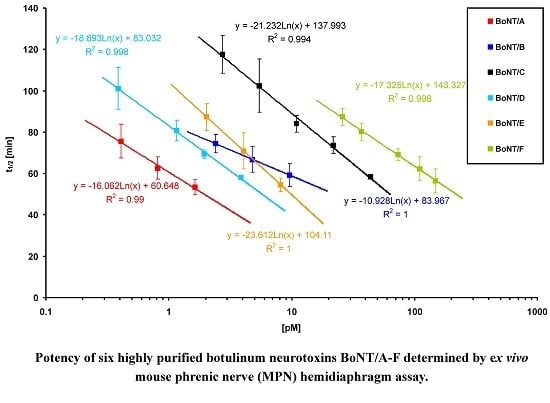Generation and Characterization of Six Recombinant Botulinum Neurotoxins as Reference Material to Serve in an International Proficiency Test
Abstract
:1. Introduction
2. Materials and Methods
2.1. Production of BoNT Proteins
2.2. Protein Analysis by Capillary Gel Electrophoresis (CGE)
2.3. Peptide Sequencing by Liquid Chromatography-Tandem Mass Spectrometry (LC-MS/MS)
2.4. Immunological Detection by Indirect Enzyme-Linked Immuno Sorbent Assay (ELISA)
2.5. In-Solution Endopep-MS Assay
2.6. Amino Acid Analysis by Liquid Chromatography-Isotope Dilution Tandem Mass Spectrometry (LC-IDMS)
2.7. Immunological Detection and Quantification by Sandwich-ELISA
2.8. Mouse Phrenic Nerve Hemidiaphragm (MPN) Assay
- y (BoNT/A; 0.408/0.81/1.63 pM) = −16.062Ln(x) + 60.648, R2 = 0.99;
- y (BoNT/B; 2.40/4.80/9.61 pM) = −10.928Ln(x) + 83.967, R2 = 1.0;
- y (BoNT/C; 2.73/5.47/10.94/21.88/43.76 pM) = −21.232Ln(x) + 137.993, R2 = 0.994;
- y (BoNT/D; 0.388/1.16/1.94/3.88 pM) = −18.893Ln(x) + 83.032, R2 = 0.998;
- y (BoNT/E; 2.04/4.08/8.15 pM) = −23.612Ln(x) + 104.11, R2 = 1.0;
- y (BoNT/F; 25.77/36.81/73.62/110.4/147.2 pM) = −17.325Ln(x) + 143.327, R2 = 0.998.
2.9. Mouse Bioassay (MBA)
3. Results
3.1. Production of Highly Purified BoNT/A–F
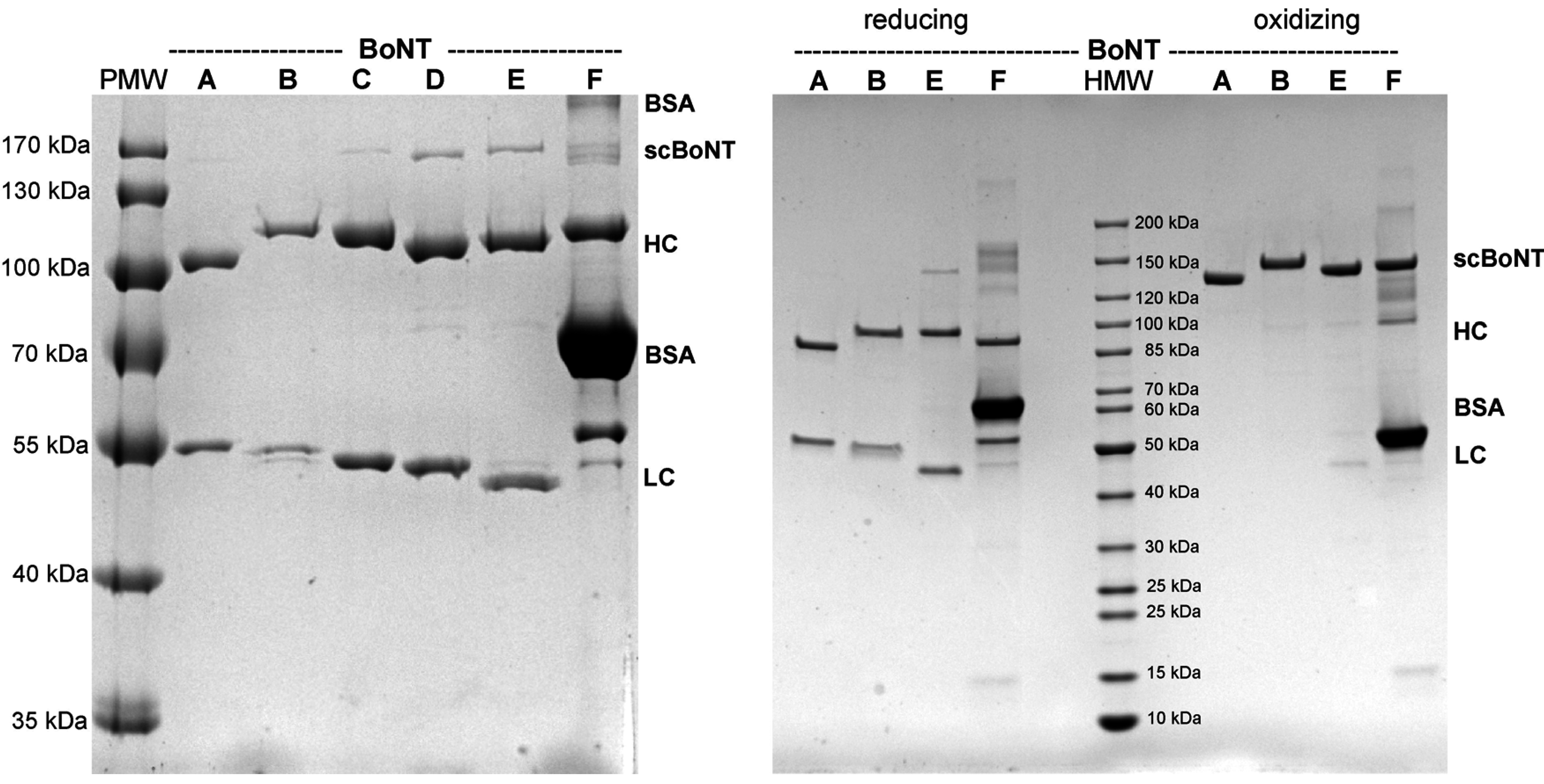
| BoNT Serotypes | Accession No. | Molecular Weight (MW) | Degree of Activation | Purity | Protein Concentration ± SD | Assigned Protein Concentration | Normalized Potency (MPN Assay) | Biological Activity (LD50) | Normalized Biological Activity | Specific Activity | ||||||
|---|---|---|---|---|---|---|---|---|---|---|---|---|---|---|---|---|
| Gene | Protein | BoNT | LC | HC | SDS-PAGE | CGE | CGE | AAA | SDS-PAGE # | |||||||
| (Da) | (Da) | (Da) | (%) | (%) | (%) | (mg/mL) | (mg/mL) | (µM) | - | (pg/mouse) | - | (U/mg) | ||||
| BoNT/A | M30196 | AAA23262 | 150,266 | 51,093 | 99,190 | 97 | 99 | 99.9 | 0.114 | ±0.007 | n.d. | 0.759 | 123 | 7.01 ± 0.53 | 6.9 | 1.43 × 108 |
| BoNT/B | M81186 | AB232927 | 152,953 | 52,341 | 100,630 | 100 | 100 | 96.0 | 0.0202 | ±0.0023 | n.d. | 0.132 | 19.2 | 20.22 ± 1.39 | 2.4 | 0.49 × 108 |
| BoNT/C | X53751 | CAA37780 | 149,770 | 51,561 | 98,226 | 95 | n.d. | n.d. | n.d. | n.d. | 0.308 | 2.054 | 2.80 | n.d. | n.d. | n.d. |
| BoNT/D | X54254 | CAA38175 | 148,106 | 51,216 | 96,907 | 88 | n.d. | n.d. | n.d. | n.d. | 0.092 | 0.620 | 34.6 | n.d. | n.d. | n.d. |
| BoNT/E | X62089 | CAA43999 | 144,776 | 48,282 | 96,512 | 92 | 95 | 93.0 | 0.156 | ±0.017 | n.d. | 1.078 | 16.2 | 24.49 ± 0.56 | 2.0 | 0.41 × 108 |
| BoNT/F | X81714 | CAA57358 | 148,201 | 50,053 | 98,165 | 90 | 97 | ~90 | n.d. | n.d. | 0.085 | 0.572 | 1 | 48.21 ± 1.13 | 1 | 0.21 × 108 |
3.2. Analysis of Purity, Degree of Activation and Molecular Weight by Capillary Gel Electrophoresis
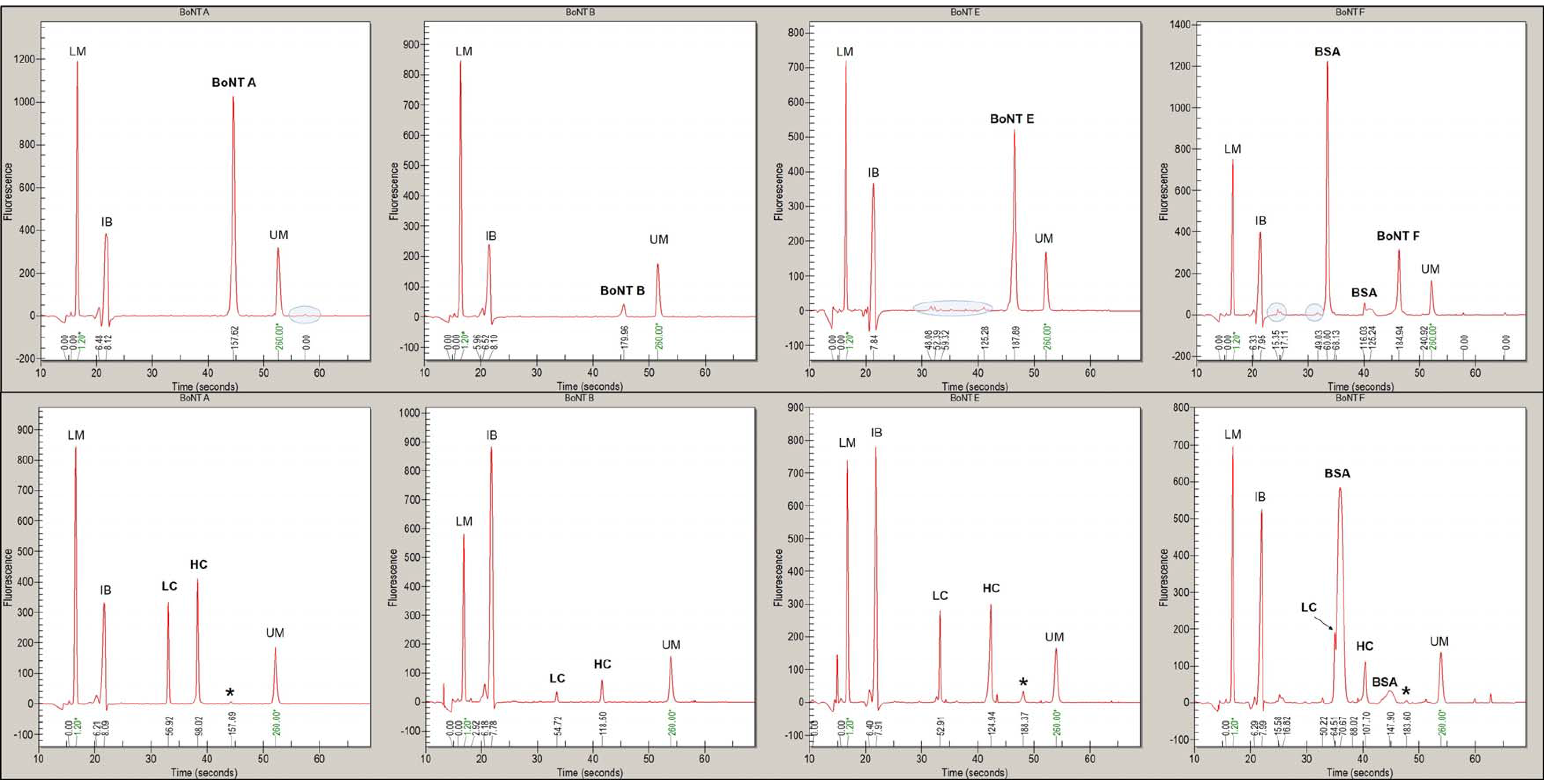
3.3. Verification of Protein Sequence Identity by Tryptic Fingerprinting and LC-MS/MS Sequencing
| Sample | Number of Peptides Identified (of Total) | Identified Peptides in HC | Identified Peptides in LC |
|---|---|---|---|
| BoNT/A | 68 (48%) | 39 | 29 |
| BoNT/B | 74 (47%) | 44 | 30 |
| BoNT/E | 64 (50%) | 48 | 16 |
| BoNT/F | 43 (33%) | 30 | 13 |
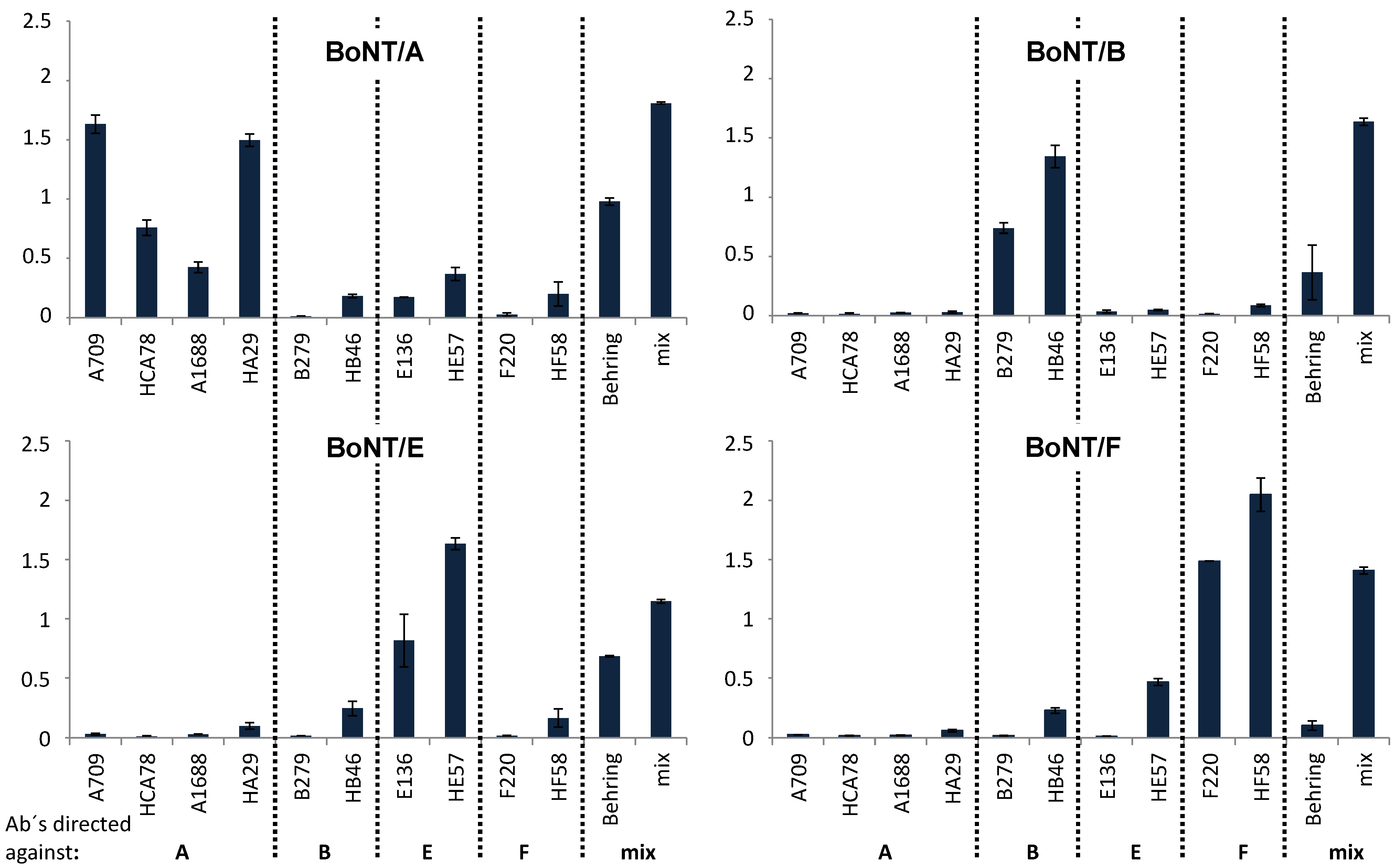
3.4. Detection of BoNT/A, B, E and F by Indirect ELISA
3.5. Determination of BoNT/A, B and E Catalytic Activity by Endopep-MS Assay

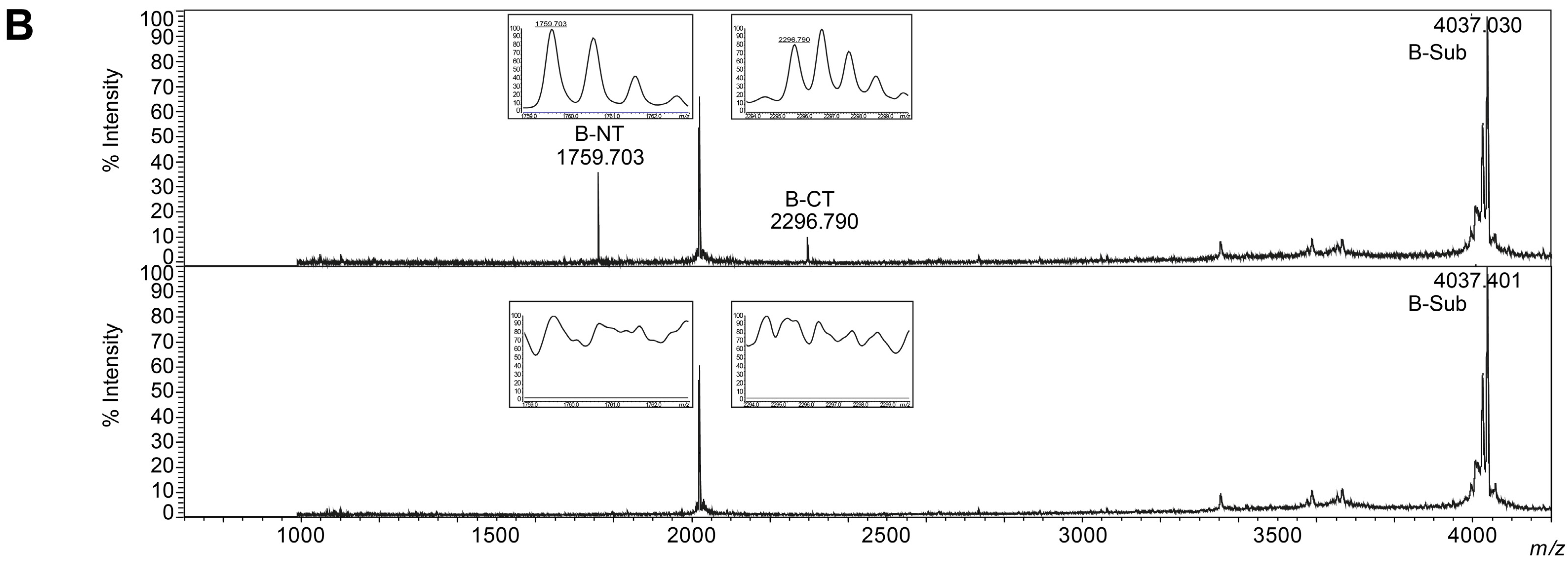

3.6. Determination of Protein Concentration of BoNT/A, B and E by AAA
3.7. Comparison of Recombinant versus Native BoNT/A, B and E by Sandwich-ELISA

3.8. Determination of BoNT/A-F Potency by the MPN Assay
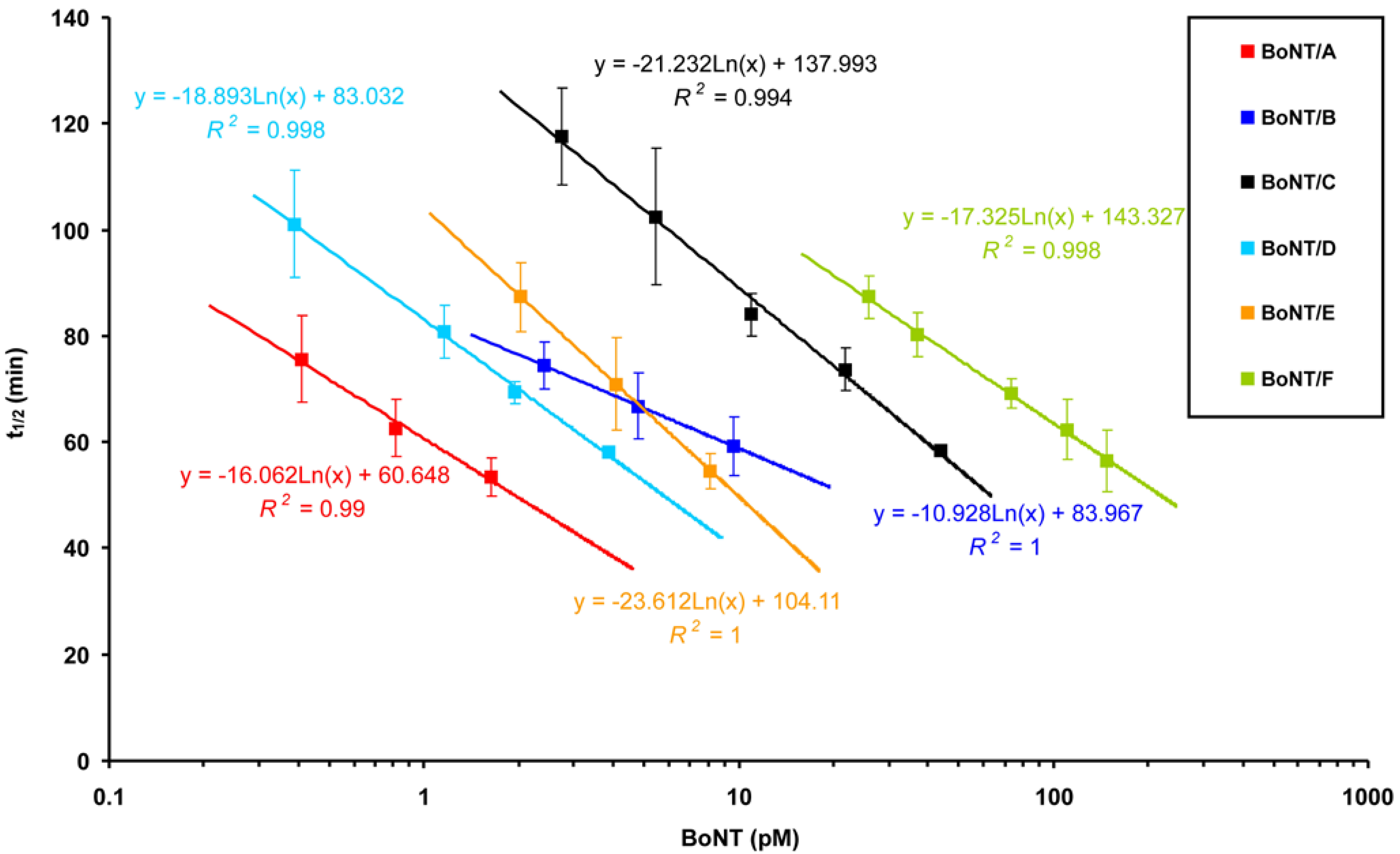
3.9. Determination of Biological Activity by Mouse Bioassay
4. Discussion
5. Conclusions
Acknowledgments
Author Contributions
Conflicts of Interest
Abbreviations
References
- Rummel, A. The long journey of Botulinum Neurotoxins into the Synapse. Toxicon 2015. [Google Scholar] [CrossRef] [PubMed]
- Bigalke, H.; Rummel, A. Medical aspects of toxin weapons. Toxicology 2005, 214, 210–220. [Google Scholar] [CrossRef] [PubMed]
- Bigalke, H. Botulinum toxin: Application, safety, and limitations. Curr. Top. Microbiol. Immunol. 2013, 364, 307–317. [Google Scholar] [PubMed]
- Hill, K.K.; Smith, T.J. Genetic diversity within Clostridium botulinum serotypes, botulinum neurotoxin gene clusters and toxin subtypes. Curr. Top. Microbiol. Immunol. 2013, 364, 1–20. [Google Scholar] [PubMed]
- Dorner, M.B.; Schulz, K.M.; Kull, S.; Dorner, B.G. Complexity of botulinum neurotoxins: Challenges for detection technology. Curr. Top. Microbiol. Immunol. 2013, 364, 219–255. [Google Scholar] [PubMed]
- Gu, S.; Rumpel, S.; Zhou, J.; Strotmeier, J.; Bigalke, H.; Perry, K.; Shoemaker, C.B.; Rummel, A.; Jin, R. Botulinum neurotoxin is shielded by NTNHA in an interlocked complex. Science 2012, 335, 977–981. [Google Scholar] [CrossRef] [PubMed]
- Matsui, T.; Gu, S.; Lam, K.H.; Carter, L.G.; Rummel, A.; Mathews, I.I.; Jin, R., II. Structural basis of the pH-dependent assembly of a botulinum neurotoxin complex. J. Mol. Biol. 2014, 426, 3773–3782. [Google Scholar] [CrossRef] [PubMed]
- Lam, K.H.; Jin, R. Architecture of the botulinum neurotoxin complex: A molecular machine for protection and delivery. Curr. Opin. Struct. Biol. 2015, 31, 89–95. [Google Scholar] [CrossRef] [PubMed]
- Lee, K.; Gu, S.; Jin, L.; Le, T.T.; Cheng, L.W.; Strotmeier, J.; Kruel, A.M.; Yao, G.; Perry, K.; Rummel, A.; et al. Structure of a bimodular botulinum neurotoxin complex provides insights into its oral toxicity. PLoS Pathog. 2013, 9, e1003690. [Google Scholar] [CrossRef] [PubMed]
- Lee, K.; Zhong, X.; Gu, S.; Kruel, A.M.; Dorner, M.B.; Perry, K.; Rummel, A.; Dong, M.; Jin, R. Molecular basis for disruption of E-cadherin adhesion by botulinum neurotoxin A complex. Science 2014, 344, 1405–1410. [Google Scholar] [CrossRef] [PubMed]
- Lee, K.; Lam, K.H.; Kruel, A.M.; Mahrhold, S.; Perry, K.; Cheng, L.W.; Rummel, A.; Jin, R. Inhibiting oral intoxication of botulinum neurotoxin A complex by carbohydrate receptor mimics. Toxicon 2015. [Google Scholar] [CrossRef] [PubMed]
- Montal, M. Botulinum neurotoxin: A marvel of protein design. Ann. Rev. Biochem. 2010, 79, 591–617. [Google Scholar] [CrossRef] [PubMed]
- Brunger, A.T.; Rummel, A. Receptor and substrate interactions of clostridial neurotoxins. Toxicon 2009, 54, 550–560. [Google Scholar] [CrossRef] [PubMed]
- Lindström, M.; Korkeala, H. Laboratory diagnostics of botulism. Clin. Microbiol. Rev. 2006, 19, 298–314. [Google Scholar] [CrossRef] [PubMed]
- Worbs, S.; Fiebig, U.; Zeleny, R.; Schimmel, H.; Rummel, A.; Luginbühl, W.; Dorner, B.G. Qualitative and Quantitative Detection of Botulinum Neurotoxins from Complex Matrices: Results of the First International Proficiency Test. Toxins 2015, 7. [Google Scholar] [CrossRef]
- Hedeland, M.; Moura, H.; Baverud, V.; Woolfitt, A.R.; Bondesson, U.; Barr, J.R. Confirmation of botulism in birds and cattle by the mouse bioassay and Endopep-MS. J. Med. Microbiol. 2011, 60, 1299–1305. [Google Scholar] [CrossRef] [PubMed]
- Lindström, M.; Myllykoski, J.; Sivela, S.; Korkeala, H. Clostridium botulinum in cattle and dairy products. Crit. Rev. Food sci. Nutr. 2010, 50, 281–304. [Google Scholar] [CrossRef] [PubMed]
- Woudstra, C.; le Marechal, C.; Souillard, R.; Bayon-Auboyer, M.H.; Anniballi, F.; Auricchio, B.; De Medici, D.; Bano, L.; Koene, M.; Sansonetti, M.H.; et al. Molecular gene profiling of Clostridium botulinum group III and its detection in naturally contaminated samples originating from various European countries. Appl. Environ. Microbiol. 2015, 81, 2495–2505. [Google Scholar] [CrossRef] [PubMed]
- Gil, L.A.; da Cunha, C.E.; Moreira, G.M.; Salvarani, F.M.; Assis, R.A.; Lobato, F.C.; Mendonca, M.; Dellagostin, O.A.; Conceicao, F.R. Production and evaluation of a recombinant chimeric vaccine against clostridium botulinum neurotoxin types C and D. PLoS ONE 2013, 8, e69692. [Google Scholar] [CrossRef] [PubMed]
- Frevert, J. Pharmaceutical, Biological, and Clinical Properties of Botulinum Neurotoxin Type A Products. Drugs R D 2015, 15, 1–9. [Google Scholar] [CrossRef] [PubMed]
- Laemmli, U.K. Cleavage of structural proteins during the assembly of the head of bacteriophage T4. Nature 1970, 227, 680–685. [Google Scholar] [CrossRef] [PubMed]
- Bergström, T.; Fredriksson, S.A.; Nilsson, C.; Astot, C. Deamidation in ricin studied by capillary zone electrophoresis- and liquid chromatography-mass spectrometry. J. Chromatogr. B 2015, 974, 109–117. [Google Scholar] [CrossRef] [PubMed]
- Pauly, D.; Kirchner, S.; Stoermann, B.; Schreiber, T.; Kaulfuss, S.; Schade, R.; Zbinden, R.; Avondet, M.A.; Dorner, M.B.; Dorner, B.G. Simultaneous quantification of five bacterial and plant toxins from complex matrices using a multiplexed fluorescent magnetic suspension assay. Analyst 2009, 134, 2028–2039. [Google Scholar] [CrossRef] [PubMed]
- Weingart, O.G.; Schreiber, T.; Mascher, C.; Pauly, D.; Dorner, M.B.; Berger, T.F.; Egger, C.; Gessler, F.; Loessner, M.J.; Avondet, M.A.; et al. The case of botulinum toxin in milk: Experimental data. Appl. Environ. Microbiol. 2010, 76, 3293–3300. [Google Scholar] [CrossRef] [PubMed]
- Pauly, D.; Dorner, M.; Zhang, X.; Hlinak, A.; Dorner, B.; Schade, R. Monitoring of laying capacity, immunoglobulin Y concentration, and antibody titer development in chickens immunized with ricin and botulinum toxins over a two-year period. Poult. Sci. 2009, 88, 281–290. [Google Scholar] [CrossRef] [PubMed]
- Simon, S.; Fiebig, U.; Liu, Y.; Tierney, R.; Dano, J.; Worbs, S.; Endermann, T.; Nevers, M.-C.; Volland, H.; Sesardic, D.; et al. Recommended Immunological Strategies to Screen for Botulinum Neurotoxin-Containing Samples. Toxins 2015, 7. [Google Scholar] [CrossRef]
- Muñoz, A.; Kral, R.; Schimmel, H. Quantification of protein calibrants by amino acid analysis using isotope dilution mass spectrometry. Anal. Biochem. 2011, 408, 124–131. [Google Scholar] [CrossRef] [PubMed]
- Rummel, A.; Bade, S.; Alves, J.; Bigalke, H.; Binz, T. Two carbohydrate binding sites in the HCC-domain of tetanus neurotoxin are required for toxicity. J. Mol. Biol. 2003, 326, 835–847. [Google Scholar] [CrossRef]
- Bigalke, H.; Rummel, A. Botulinum Neurotoxins: Qualitative and Quantitative Analysis Using the Mouse Phrenic Nerve Hemidiaphragm Assay (MPN). Toxins 2015, 7. [Google Scholar] [CrossRef]
- Reed, L.J.; Muench, H. A simple method of estimating 50% endpoints. Am. J. Hyg. 1938, 27, 493–497. [Google Scholar]
- Pearce, L.B.; Borodic, G.E.; First, E.R.; MacCallum, R.D. Measurement of botulinum toxin activity: Evaluation of the lethality assay. Toxicol. Appl. Pharmacol. 1994, 128, 69–77. [Google Scholar] [CrossRef] [PubMed]
- Rummel, A.; Mahrhold, S.; Bigalke, H.; Binz, T. The HCC-domain of botulinum neurotoxins A and B exhibits a singular ganglioside binding site displaying serotype specific carbohydrate interaction. Mol. Microbiol. 2004, 51, 631–643. [Google Scholar] [CrossRef] [PubMed]
- Rummel, A.; Häfner, K.; Mahrhold, S.; Darashchonak, N.; Holt, M.; Jahn, R.; Beermann, S.; Karnath, T.; Bigalke, H.; Binz, T. Botulinum neurotoxins C, E and F bind gangliosides via a conserved binding site prior to stimulation-dependent uptake with botulinum neurotoxin F utilising the three isoforms of SV2 as second receptor. J. Neurochem. 2009, 110, 1942–1954. [Google Scholar] [CrossRef] [PubMed]
- Strotmeier, J.; Lee, K.; Völker, A.K.; Mahrhold, S.; Zong, Y.; Zeiser, J.; Zhou, J.; Pich, A.; Bigalke, H.; Binz, T.; et al. Botulinum neurotoxin serotype D attacks neurons via two carbohydrate-binding sites in a ganglioside-dependent manner. Biochem. J. 2010, 431, 207–216. [Google Scholar] [CrossRef] [PubMed]
- Rummel, A.; Mahrhold, S.; Bigalke, H.; Binz, T. Exchange of the HCC domain mediating double receptor recognition improves the pharmacodynamic properties of botulinum neurotoxin. FEBS J. 2011, 278, 4506–4515. [Google Scholar] [CrossRef] [PubMed]
- Kalb, S.R.; Krilich, J.C.; Dykes, J.K.; Luquez, C.; Maslanka, S.E.; Barr, J.R. Detection of Botulinum Toxins A, B, E, and F in Foods by Endopep-MS. J. Agric. Food Chem. 2015, 63, 1133–1141. [Google Scholar] [CrossRef] [PubMed]
- Kalb, S.R.; Baudys, J.; Wang, D.; Barr, J.R. Recommended mass spectrometry-based strategies to identify botulinum neurotoxin-containing samples. Toxins 2015, 7, 1765–1778. [Google Scholar] [CrossRef] [PubMed]
- Kalb, S.R.; Moura, H.; Boyer, A.E.; McWilliams, L.G.; Pirkle, J.L.; Barr, J.R. The use of Endopep-MS for the detection of botulinum toxins A, B, E, and F in serum and stool samples. Anal. Biochem. 2006, 351, 84–92. [Google Scholar] [CrossRef] [PubMed]
- Kalb, S.R.; Garcia-Rodriguez, C.; Lou, J.; Baudys, J.; Smith, T.J.; Marks, J.D.; Smith, L.A.; Pirkle, J.L.; Barr, J.R. Extraction of BoNT/A, /B, /E, and /F with a single, high affinity monoclonal antibody for detection of botulinum neurotoxin by Endopep-MS. PLoS One 2010, 5. [Google Scholar] [CrossRef] [PubMed]
- Rosen, O.; Feldberg, L.; Gura, S.; Zichel, R. Improved detection of botulinum type E by rational design of a new peptide substrate for endopeptidase-mass spectrometry assay. Anal. Biochem. 2014, 456, 50–52. [Google Scholar] [CrossRef] [PubMed]
- Wang, D.; Krilich, J.; Baudys, J.; Barr, J.R.; Kalb, S.R. Optimization of peptide substrates for botulinum neurotoxin E improves detection sensitivity in the Endopep-MS assay. Anal. Biochem. 2014, 468C, 15–21. [Google Scholar] [CrossRef] [PubMed]
- Schantz, E.J.; Johnson, E.A. Properties and use of botulinum toxin and other microbial neurotoxins in medicine. Microbiol. Rev. 1992, 56, 80–99. [Google Scholar] [PubMed]
- Bryant, A.M.; Davis, J.; Cai, S.; Singh, B.R. Molecular composition and extinction coefficient of native botulinum neurotoxin complex produced by Clostridium botulinum hall A strain. Protein J. 2013, 32, 106–117. [Google Scholar] [CrossRef] [PubMed]
- Gornall, A.G.; Bardawill, C.J.; David, M.M. Determination of serum proteins by means of the biuret reaction. J. Biol. Chem. 1949, 177, 751–766. [Google Scholar] [PubMed]
- Bradford, M.M. A rapid and sensitive method for the quantitation of microgram quantities of protein utilizing the principle of protein-dye binding. Anal. Biochem. 1976, 72, 248–254. [Google Scholar] [CrossRef]
- Lowry, O.H.; Rosebrough, N.J.; Farr, A.L.; Randall, R.J. Protein measurement with the Folin phenol reagent. J. Biol. Chem. 1951, 193, 265–275. [Google Scholar] [PubMed]
- McKenzie, H.A.; Wallace, H.S. The Kjeldahl determination of nitrogen: A critical study of digestion conditions. Aust. J. Chem. 1954, 7, 55–70. [Google Scholar] [CrossRef]
- Bülbring, E. Observations on the isolated phrenic nerve diaphragm preparation of the rat. Br. J. Pharmacol. Chemother. 1946, 1, 38–61. [Google Scholar] [CrossRef] [PubMed]
- Simpson, L.L.; Rapport, M.M. The binding of botulinum toxin to membrane lipids: Sphingolipids, steroids and fatty acids. J. Neurochem. 1971, 18, 1751–1759. [Google Scholar] [CrossRef] [PubMed]
- Habermann, E.; Dreyer, F.; Bigalke, H. Tetanus toxin blocks the neuromuscular transmission in vitro like botulinum A toxin. Naunyn. Schmiedebergs Arch. Pharmacol. 1980, 311, 33–40. [Google Scholar] [CrossRef] [PubMed]
- Wohlfarth, K.; Goschel, H.; Frevert, J.; Dengler, R.; Bigalke, H. Botulinum A toxins: Units versus units. Naunyn. Schmiedebergs Arch. Pharmacol. 1997, 355, 335–340. [Google Scholar] [CrossRef] [PubMed]
- EDQM. European Pharmacopoeia 5th ed., Council of Europe. 01/2005:2113. Botulinum Toxin Type A for Injection. Eur. Pharmacop. 2006, 1117–1119. [Google Scholar]
- Sesardic, D.; Leung, T.; Gaines Das, R. Role for standards in assays of botulinum toxins: International collaborative study of three preparations of botulinum type A toxin. Biologicals 2003, 31, 265–276. [Google Scholar] [CrossRef] [PubMed]
- Adler, S.; Bicker, G.; Bigalke, H.; Bishop, C.; Blumel, J.; Dressler, D.; Fitzgerald, J.; Gessler, F.; Heuschen, H.; Kegel, B.; et al. The current scientific and legal status of alternative methods to the LD50 test for botulinum neurotoxin potency testing. The report and recommendations of a ZEBET Expert Meeting. Altern. Lab. Anim. 2010, 38, 315–330. [Google Scholar] [PubMed]
- Sakaguchi, G. Clostridium botulinum toxins. Pharmacol. Ther. 1982, 19, 165–194. [Google Scholar] [CrossRef]
- Rummel, A.; Eichner, T.; Weil, T.; Karnath, T.; Gutcaits, A.; Mahrhold, S.; Sandhoff, K.; Proia, R.L.; Acharya, K.R.; Bigalke, H.; et al. Identification of the protein receptor binding site of botulinum neurotoxins B and G proves the double-receptor concept. Proc. Natl. Acad. Sci. USA 2007, 104, 359–364. [Google Scholar] [CrossRef] [PubMed]
- Wang, J.; Meng, J.; Lawrence, G.W.; Zurawski, T.H.; Sasse, A.; Bodeker, M.O.; Gilmore, M.A.; Fernandez-Salas, E.; Francis, J.; Steward, L.E.; et al. Novel chimeras of botulinum neurotoxins A and E unveil contributions from the binding, translocation, and protease domains to their functional characteristics. J. Biol. Chem. 2008, 283, 16993–17002. [Google Scholar] [CrossRef] [PubMed]
- Wang, J.; Zurawski, T.H.; Meng, J.; Lawrence, G.W.; Aoki, K.R.; Wheeler, L.; Dolly, J.O. Novel chimeras of botulinum and tetanus neurotoxins yield insights into their distinct sites of neuroparalysis. FASEB J. 2012, 26, 5035–5048. [Google Scholar] [CrossRef] [PubMed]
- Wang, J.; Zurawski, T.H.; Bodeker, M.O.; Meng, J.; Boddul, S.; Aoki, K.R.; Dolly, J.O. Longer-acting and highly potent chimaeric inhibitors of excessive exocytosis created with domains from botulinum neurotoxin A and B. Biochem. J. 2012, 444, 59–67. [Google Scholar] [CrossRef] [PubMed]
- Sikorra, S.; Henke, T.; Galli, T.; Binz, T. Substrate Recognition Mechanism of VAMP/Synaptobrevin-cleaving Clostridial Neurotoxins. J. Biol. Chem. 2008, 283, 21145–21152. [Google Scholar] [CrossRef] [PubMed]
- Sugiyama, H. Clostridium botulinum neurotoxin. Microbiol. Rev. 1980, 44, 419–448. [Google Scholar] [PubMed]
© 2015 by the authors; licensee MDPI, Basel, Switzerland. This article is an open access article distributed under the terms and conditions of the Creative Commons by Attribution (CC-BY) license (http://creativecommons.org/licenses/by/4.0/).
Share and Cite
Weisemann, J.; Krez, N.; Fiebig, U.; Worbs, S.; Skiba, M.; Endermann, T.; Dorner, M.B.; Bergström, T.; Muñoz, A.; Zegers, I.; et al. Generation and Characterization of Six Recombinant Botulinum Neurotoxins as Reference Material to Serve in an International Proficiency Test. Toxins 2015, 7, 5035-5054. https://doi.org/10.3390/toxins7124861
Weisemann J, Krez N, Fiebig U, Worbs S, Skiba M, Endermann T, Dorner MB, Bergström T, Muñoz A, Zegers I, et al. Generation and Characterization of Six Recombinant Botulinum Neurotoxins as Reference Material to Serve in an International Proficiency Test. Toxins. 2015; 7(12):5035-5054. https://doi.org/10.3390/toxins7124861
Chicago/Turabian StyleWeisemann, Jasmin, Nadja Krez, Uwe Fiebig, Sylvia Worbs, Martin Skiba, Tanja Endermann, Martin B. Dorner, Tomas Bergström, Amalia Muñoz, Ingrid Zegers, and et al. 2015. "Generation and Characterization of Six Recombinant Botulinum Neurotoxins as Reference Material to Serve in an International Proficiency Test" Toxins 7, no. 12: 5035-5054. https://doi.org/10.3390/toxins7124861
APA StyleWeisemann, J., Krez, N., Fiebig, U., Worbs, S., Skiba, M., Endermann, T., Dorner, M. B., Bergström, T., Muñoz, A., Zegers, I., Müller, C., Jenkinson, S. P., Avondet, M.-A., Delbrassinne, L., Denayer, S., Zeleny, R., Schimmel, H., Åstot, C., Dorner, B. G., & Rummel, A. (2015). Generation and Characterization of Six Recombinant Botulinum Neurotoxins as Reference Material to Serve in an International Proficiency Test. Toxins, 7(12), 5035-5054. https://doi.org/10.3390/toxins7124861






